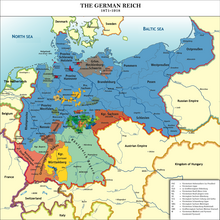Central Germany (cultural area)
This article needs additional citations for verification. (October 2011) |
Central Germany (
The name dates from the German Empire, when the region was approximately in the centre of the country. Since the German Empire's eastern territories became part of Poland and Russia in the aftermath of World War II, "Central Germany" has been located east of the centre of the country, but the name is still often used in business, media and by the Central German Metropolitan Region. Against this background, the term is not or no longer to be understood as a geographic term.
History

Historically also including most of
19th century until World War II
Until
After 1945, when Germany lost its
For decades until Chancellor
Post-reunification

After the 1990
In 1991, the states of Saxony, Saxony-Anhalt, and Thuringia founded the public regional broadcaster Mitteldeutscher Rundfunk (Middle German Broadcasting), a member of the ARD network. Private companies located in the area of Leipzig, Halle and Dessau often use the term "Central Germany", as do the Evangelical Church in Central Germany and some sports competitions, such as the Mitteldeutsche Meisterschaften (Central German Championships).
The Central German Metropolitan Region comprises a regional development zone in the European METREX network (see below).
Although most methods for determining the geographical center of Germany result in a point in "Central Germany" (for example Niederdorla in western Thuringia), the three-state area also comprises Görlitz, the easternmost town in Germany, which lies on the border with Poland. Arguably, this eastern part, although part of the state of Saxony, is not part of the central German cultural region, as historically, the Lusatia region has its own history and traditions (see i.a. the Lusatian League), being closely linked to Bohemia. The same is true for Magdeburg and the areas surrounding it (i.e. the areas north of Anhalt) as they neither belong to the central German dialect group nor do they have a close cultural connection with the more southern parts, they were traditionally connected to Brandenburg and Prussia.
Cultural significance
Central Germany has played a crucial role in the development of German culture and identity. Already in medieval times, the region laid at the crossroads of two major trade routes in central Europe, the
UNESCO World Heritage Sites
Central Germany is home to several UNESCO World Heritage Sites.
- Medieval city, Collegiate Church and Castle Quedlinburg
- Luthergedenkstätten
- Dessau-Wörlitz Gartenreich (Dessau-Wörlitz Garden Realm)
- Bauhaus (modernist school of architecture and design)
- Naumburg Cathedral
- Wartburg castle
- Classical Weimar
- Ore Mountain Mining Region
- Old Synagoge (Erfurt)
- Nebra sky disk (enlisted in the UNESCO Memory of the World Programme)
Administrative structure
Present central Germany is part of three German federal states: Saxony, Saxony-Anhalt and Thuringia. A large part of the region is part of the Central German Metropolitan Region which comprises a regional development zone in the European METREX network. As of 2014[update] it includes major cities in Thuringia and Saxony-Anhalt, as well as the "Saxon triangle" of cities that set up the organization in 1994 (Leipzig, Halle, Dresden and Chemnitz-Zwickau).[5]
Examples of use

- Central German Metropolitan Region (seven cities in Saxony, Thuringia and Saxony-Anhalt)
- Mitteldeutscher Rundfunk (Saxony, Thuringia and Saxony-Anhalt)
- Mitteldeutsche Zeitung, Central German Newspaper (Halle/southern Saxony-Anhalt only)
- in Saxony)
- Evangelical Church in Central Germany (Thuringia, most of Saxony-Anhalt, some of Saxony, some of Brandenburg – see all German Evangelical churches)
- S-Bahn Mitteldeutschland, a rapid transit and regional rail system
- Central German football championship (1902–1933: modern-day Saxony, Thuringia, Saxony-Anhalt with exception of the northern parts; plus Duderstadt, Neustadt bei Coburg and others[6])
- Mitteldeutscher Basketball Club (Weißenfels in Saxony-Anhalt)
- Chemie Volley Mitteldeutschland, a volleyball club based in Spergau in the district Saalekreis, Saxony-Anhalt, Germany
See also
- East Central German dialects
- Anton Wilhelm Amo (Philosopher, first African person who attended a German university and becoming the first German professor of African heritage)
References
- ^ Werner König, "Mitteldeutschland als geografischer Begriff", in: dtv-Atlas Deutsche Sprache, December 2007, p. 120
- ISBN 978-3-89812-530-7,
Auch die mittelalterliche und frühneuzeitliche wettinische Herrschaft in Mitteldeutschland ist, […]. Mit Fußnote an Mitteldeuschland: Zum Begriff Mitteldeutschland vgl. Wolf, Wandlungen des Begriffs „Mitteldeutschland", S. 3–24; Blaschke, Mitteldeutschland als geschichtlich-landeskundlicher Begriff, S. 13–24; Rutz, Mitteldeutschland. In Gesellschaft und Kultur Band 1, S. 225–258
- ^ Schreiber, Mathias (2006). Deutsch for sale, Der Spiegel, no. 40, October 2, 2006 ("So schuf er eine Hochsprache aus Volkssprache, sächsischem Kanzleideutsch (aus der Gegend von Meißen), Predigt und Alltagsrede, eine in sich widersprüchliche, aber bildhafte und kraftvolle Mischung, an der die deutschsprachige Literatur im Grunde bis heute Maß nimmt.")
- ^ Der Spiegel: 100 Jahre Weimarer Republik Warum Weimar?, ("Die Verlegung der Nationalversammlung nach dem Herzen Deutschlands wird den Einheitsgedanken, die Zusammengehörigkeit des Reiches mächtig stärken." (Friedrich Ebert)
- ^ Region Mitteldeutschland: history Archived August 20, 2013, at the Wayback Machine Retrieved 30 Oct 2010
- ^ Verband Mitteldeutscher Ballspiel-Vereine, German Wikipedia Retrieved 2 Nov 2011
External links
- Website of the mitteldeutschland campaign (in German)
- Central German Metropolitan Region (in English)
